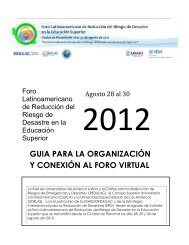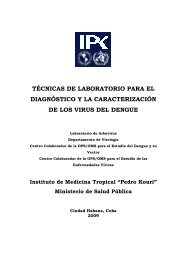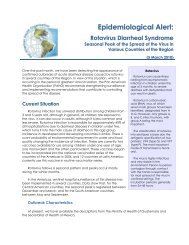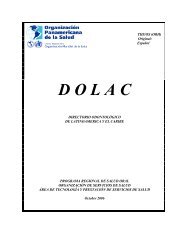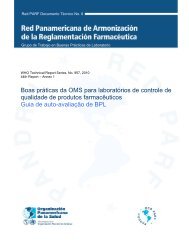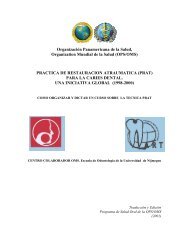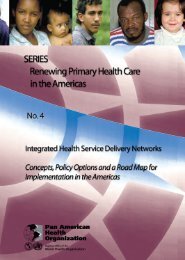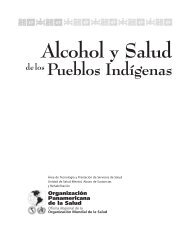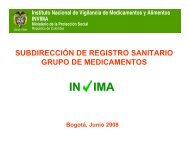Health response to the earthquake in Haiti, January 2010
Health response to the earthquake in Haiti, January 2010
Health response to the earthquake in Haiti, January 2010
- No tags were found...
Create successful ePaper yourself
Turn your PDF publications into a flip-book with our unique Google optimized e-Paper software.
<strong>Health</strong> <strong>response</strong> <strong>to</strong> <strong>the</strong> <strong>earthquake</strong> <strong>in</strong> <strong>Haiti</strong> <strong>January</strong> <strong>2010</strong>Table 3.9 Numbers of persons liv<strong>in</strong>g <strong>in</strong> temporary shelters<strong>in</strong> <strong>Haiti</strong> after <strong>earthquake</strong>, by sourceSourcePDNA (March <strong>2010</strong>)IOM Registration Strategy (April<strong>2010</strong>)IOM Press Brief<strong>in</strong>g Note (Dec <strong>2010</strong>)USAID survey (Schwartz et al. 2011)Data1.5 M persons directly affectedAround 1.3 M liv<strong>in</strong>g <strong>in</strong> temporary shelters <strong>in</strong> <strong>the</strong> metropolitanPort-au-Pr<strong>in</strong>ce area; 500,000 moved <strong>in</strong><strong>to</strong> <strong>the</strong> res<strong>to</strong>f <strong>the</strong> country450,000 households liv<strong>in</strong>g <strong>in</strong> shelters a (i.e., at least 2 Mpersons)Peak figure <strong>in</strong> <strong>the</strong> camps was 1.5 MEstimated number of people who went <strong>to</strong> camps <strong>in</strong><strong>January</strong> is 866,412 <strong>to</strong> 894,588 ( p < .01)By April <strong>2010</strong>, approximately half of those who had gone<strong>to</strong> camps or <strong>the</strong> countryside had returned homea Accord<strong>in</strong>g <strong>to</strong> <strong>the</strong> IOM, household size is estimated between 5.2 and 5.7 persons.The lesson is that any statistic, not only mortality data, can only be a rough estimatelikely <strong>to</strong> be subject <strong>to</strong> question<strong>in</strong>g. The key aga<strong>in</strong> is <strong>to</strong> resist <strong>the</strong> temptation <strong>to</strong> errsystematically <strong>to</strong> <strong>the</strong> higher side and <strong>to</strong> share <strong>the</strong> methodology adopted as was done<strong>in</strong> this case. There is no real benefit for <strong>the</strong> affected population <strong>to</strong> adopt <strong>the</strong> higherend of all measurements. A middle road approach will more likely make divergencebetween experts a matter of scientific debate ra<strong>the</strong>r than a public crisis affect<strong>in</strong>g <strong>the</strong>credibility of an agency.Faced with <strong>the</strong> situation <strong>in</strong> Port-au-Pr<strong>in</strong>ce, <strong>the</strong> Government encouraged migration <strong>to</strong> nonaffecteddepartments, and buses were rapidly made ready <strong>to</strong> transport people. S<strong>in</strong>ce roads<strong>in</strong> <strong>the</strong> affected area were impassable, buses were located at <strong>the</strong> periphery. Movements ofpeople away from <strong>the</strong> capital started spontaneously, dur<strong>in</strong>g <strong>the</strong> night of 12 <strong>January</strong>; <strong>the</strong>first arrivals of <strong>the</strong> <strong>in</strong>jured were reported <strong>in</strong> <strong>the</strong> early morn<strong>in</strong>g of 13 <strong>January</strong> at Sa<strong>in</strong>t Marsand Gonaïves hospitals. The flow of “evacuated <strong>in</strong>jured people” cont<strong>in</strong>ued for a few days,rapidly overstretch<strong>in</strong>g <strong>the</strong> <strong>response</strong> capacities of <strong>the</strong>se facilities. <strong>Health</strong> services <strong>in</strong> <strong>the</strong> receiv<strong>in</strong>gareas, which were already <strong>in</strong>sufficient <strong>to</strong> meet <strong>the</strong> most basic needs of <strong>the</strong> localpopulation, had <strong>to</strong> attend <strong>to</strong> a flux of reportedly between 500,000 and 600,000 disasteraffected<strong>in</strong>dividuals, many with <strong>in</strong>juries and emergency treatment needs. These healthfacilities normally charged for services, habitually saw only a few patients daily, and had nos<strong>to</strong>cks of supplies <strong>to</strong> serve <strong>the</strong> <strong>in</strong>crease <strong>in</strong> patients. How long <strong>the</strong> extra medical burden onnon-affected departments lasted is unclear.If efforts were made by <strong>the</strong> Government <strong>to</strong> encourage and moni<strong>to</strong>r <strong>the</strong> <strong>in</strong>itial movemen<strong>to</strong>ut of Port-au-Pr<strong>in</strong>ce, few data were sought by or provided <strong>to</strong> <strong>the</strong> humanitariancommunity on <strong>the</strong> return of those displaced.The Rapid Initial Needs Assessment for <strong>Haiti</strong> (RINAH) is one of <strong>the</strong> few studies thatexplored this issue <strong>in</strong> some depth. 29 Ano<strong>the</strong>r survey commissioned by UNFPA confirmsthat more than a quarter of <strong>the</strong> population of <strong>the</strong> metropolitan area left after <strong>the</strong>12 <strong>January</strong> <strong>earthquake</strong> (<strong>Haiti</strong> Data Services <strong>2010</strong>). Half migrated <strong>in</strong><strong>to</strong> urban areas of29 See: Assessment Capacities (ACAPS), <strong>2010</strong>, Rapid <strong>in</strong>itial needs assessment for <strong>Haiti</strong> (RINAH).34




